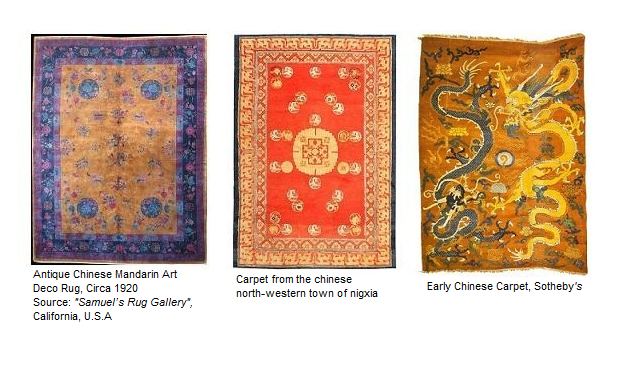The centuries old Chinese textile industry is rich in history. While most antique carpets are classified according to a specific region or manufactory, scholars attribute the age of any specific Chinese rug to the ruling emperor of the time. The earliest surviving examples of the craft were produced during the time of Ch'ung Chen, the last emperor of the Chen Dynasty. Carpet weaving in China was not a greatly accepted artwork until around the latter half of 1700. It was a period much after any other Oriental carpet weaving location. Two of the reasons behind can be the scarcity of wool in China and the showcase of the Chinese aesthetic works that reflected the refinement and calligraphic perfection of which they were demur.

China has a long history of exporting traditional goods. Initially, as opposed to most antique rug manufacturing practices, Chinese carpets were woven almost exclusively for internal consumption. They were essentially ornamental for those of high stature and wealth who could afford to purchase them or have them made. However, it was not until the first half of the 19th century that the Chinese began to export their rugs. Once in contact with western influences, there was a large change in production: Chinese manufacturers began to produce art-deco rugs with commercial look and price point. In the 1920s through the mid-thirties, production in China was cheap as it is now, prompting the art deco rug makers of the time to get manufacture their goods in China. These rugs featured bright colors such as lapis blue in the place of the soft blue of traditional Chinese rugs, with novel uses of traditional and new Chinese motifs incorporated in a distinctly art deco manner. The two most famous rug companies from this period, named after their makers, are the Fette and Nichols rugs, still considered to be representative of a unique time in history and a unique and vibrant style of rugs. The Fette style of Chinese area rug, due to the thinness and pliability of the cotton warp used, were soft and supple compared to the Nichols rugs that utilized 'Nichols Super Yarn', which was machine spun and had considerable strength. This, in combination with the strong cotton used in the foundation of the rug, resulted in a product that was dense and heavy.
Antique Chinese rugs commonly feature colors including white, red, yellow, blue and fawn. Boundaries between colors are often "sculpted", which distinguishes areas by texture as well as color. The Chinese carpets are a beautiful amalgamation of flowers as well as abstract geometrical figures, curvilinear in nature. The blend does not create any confusion but a distinct style that is even-handed as well as graceful. For instance, with a central medallion accompanied with four corner medallions. Mythical flowers, animals, are also grouped together, generally in a circle with precision. The inimitably tinted Chinese carpets generally exhibit symbols, which are inspired from the natural world, ancient local myths, Buddhism, and Taoism. Intriguingly, every symbol carries a peculiar meaning with it that is not simple to decipher.
Sources and inspiration: Bérinstain, Valérie, et al. L'art du tapis dans le monde (The art of carpets in the world),. Paris: Mengès, 1996. Print.; Jerrehian Jr., Aram K.A. Oriental Rug Primer. Philadelphia: Running Press, 1980. Print.; Herbert, Janice Summers. Oriental Rugs, New York: Macmillan, 1982. Print.; Hackmack, Adolf. Chinese Carpets and Rugs, Rutland and Tokyo: Tuttle, 1980. Print. ; De Moubray, Amicia, and David Black. Carpets for the home, London: Laurence King Publishing, 1999. Print.; Jacobsen, Charles. Oriental Rugs A Complete Guide, Rutland and Tokyo: Tuttle, 1962. Print.; Bashir, S. (n.d.). Personal interview.; Web site sources and dates of consultation vary (to be confirmed). Without prejudice to official usage.


 Tapis d'Orient Bashir | Bashir Persian Rugs
Tapis d'Orient Bashir | Bashir Persian Rugs
 @tapisbashir
@tapisbashir
 @bashircarpets
@bashircarpets
 @bashircarpets
@bashircarpets